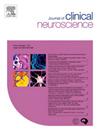氯胺酮和硫酸镁辅助布比卡因用于幕上开颅术头皮阻滞的镇痛效果比较:一项随机、双盲临床研究
IF 1.8
4区 医学
Q3 CLINICAL NEUROLOGY
引用次数: 0
摘要
背景:开颅手术期间有效的疼痛管理对于优化血流动力学、恢复和患者满意度至关重要。本研究评估了氯胺酮和硫酸镁作为布比卡因佐剂在预防性头皮阻滞中的疗效,重点关注血流动力学、术后疼痛和镇痛药的使用。方法将102例幕上开颅手术患者随机分为K组(氯胺酮)、M组(硫酸镁)和C组(生理盐水),每组34例。每组患者均接受布比卡因和相应佐剂的抢先头皮阻滞。在不同时间点测量血流动力学、术后疼痛(Critical-Care pain Observation Tool, CPOT)和镇痛药消耗。结果共分析了97例患者。头皮阻滞降低了所有组对针插入的血流动力学反应。氯胺酮组术中芬太尼用量(191.82±53.18µg)明显低于生理盐水组(304.06±48.73µg)和镁组(275.31±59.04µg), p <;0.001)。氯胺酮组(12.97±4.13)比生理盐水组(3.03±1.47)和镁组(4.19±1.45,p <;0.001)。氯胺酮组术后4 h CPOT评分最低(0.30±0.53),镁组(1.12±0.66)和生理盐水组(1.66±0.55),p <;0.001)。结论头皮阻滞,不论有无佐剂,均能有效控制针的反应。本研究强调氯胺酮作为布比卡因的一种有价值的辅助剂,可显著减少止痛药的消耗并延长疼痛缓解。镁提供适度的益处。这些研究结果支持在开颅术中预先使用氯胺酮在头皮阻滞中增强镇痛和维持血流动力学稳定性。然而,需要进一步研究氯胺酮的血清水平,以确定这种作用是作为局部麻醉剂的辅助作用还是由于其全身吸收。本文章由计算机程序翻译,如有差异,请以英文原文为准。

Comparative Evaluation of analgesic efficacy of ketamine and magnesium sulfate as adjuvants to bupivacaine for scalp block in supratentorial Craniotomy: A Randomized, Double-Blind clinical study
Background
Effective pain management during craniotomy is crucial for optimizing hemodynamics, recovery, and patient satisfaction. This study evaluated the efficacy of ketamine and magnesium sulfate as adjuvants to bupivacaine in preemptive scalp blocks, focusing on hemodynamics, postoperative pain, and analgesic consumption.
Methods
This study included 102 patients undergoing supratentorial craniotomy, randomized into three groups (n = 34 in each): Group K (ketamine), Group M (magnesium sulfate), and Group C (saline). Each group received a preemptive scalp block with bupivacaine with the respective adjuvants. Hemodynamics, postoperative pain (Critical-Care Pain Observation Tool, CPOT), and analgesic consumption were measured at various time points.
Results
Ninety-seven patients were analyzed. Scalp block reduced the hemodynamic response to pin insertion in all groups. Intra-operative fentanyl consumption was significantly lower in the ketamine (191.82 ± 53.18 µg) compared to the saline (304.06 ± 48.73 µg) and magnesium groups (275.31 ± 59.04 µg, p < 0.001). The time (hours) to the first post-operative analgesic demand was longer in the ketamine (12.97 ± 4.13) compared to the saline (3.03 ± 1.47) and magnesium groups (4.19 ± 1.45, p < 0.001). Ketamine resulted in the lowest CPOT scores at 4 h (0.30 ± 0.53) post-operatively compared to magnesium (1.12 ± 0.66) and saline (1.66 ± 0.55, p < 0.001).
Conclusions
Scalp block, with or without adjuvants, is effective in managing pin response. This study highlights ketamine as a valuable adjuvant to bupivacaine, significantly reducing analgesic consumption and prolonging pain relief. Magnesium provides moderate benefits. These findings support the preemptive use of ketamine in scalp block to enhance analgesia and maintain hemodynamic stability during craniotomy. However, further studies are needed to correlate the serum levels of ketamine to identify whether the effect is as adjuvant to local anesthetic or due to its systemic absorption.
求助全文
通过发布文献求助,成功后即可免费获取论文全文。
去求助
来源期刊

Journal of Clinical Neuroscience
医学-临床神经学
CiteScore
4.50
自引率
0.00%
发文量
402
审稿时长
40 days
期刊介绍:
This International journal, Journal of Clinical Neuroscience, publishes articles on clinical neurosurgery and neurology and the related neurosciences such as neuro-pathology, neuro-radiology, neuro-ophthalmology and neuro-physiology.
The journal has a broad International perspective, and emphasises the advances occurring in Asia, the Pacific Rim region, Europe and North America. The Journal acts as a focus for publication of major clinical and laboratory research, as well as publishing solicited manuscripts on specific subjects from experts, case reports and other information of interest to clinicians working in the clinical neurosciences.
 求助内容:
求助内容: 应助结果提醒方式:
应助结果提醒方式:


